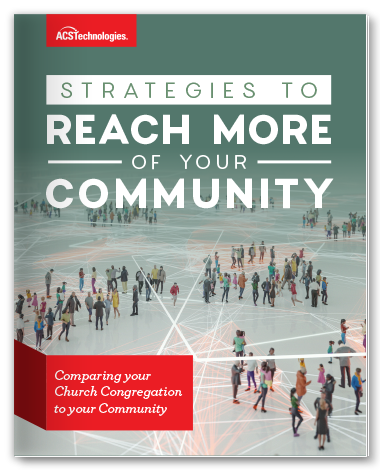The word “comparison” can have a negative connotation at first glance. We teach our young children not to compare themselves to what others do or wear or have and that they are wonderful (within reason) just the way they are. However, if we look closely at the literal definition: “An examination of two or more items to establish similarities and dissimilarities,” we can then welcome the point of comparison for what it is, especially in relation to how to better serve our congregants and our community.
Are we reflecting Christ as a church? How do we know if we are? Is there data to help back up what we think and, more importantly, what we are missing? How can we fill in the gaps? I came across this resource, Comparing your Church Congregation To Your Community, and it articulates step by step how to laser in on the community and church members for the sole purpose of connecting personally with them while also discovering the challenges in their lives to gain more clarity in how to better carry each other’s burdens according to Galatians 6:2. When it comes to our local hands-on outreach, this premise should collectively embody our 2023 church vision casting. Amen?
An article from Barna offers these seven consistent elements of local church communities in the New Testament and further challenges, “Discipleship is not an academic journey. It has to involve real human beings in a real community. If the church is an interpersonal family of people who I have a responsibility to contribute to, it becomes a community.”
- Spiritual engagement (Colossians 3:16)
- Preaching the Word (Hebrews 13:7)
- Worship and prayer (1 Timothy 2:8)
- Evangelism (Acts of the Apostles 1:8)
- Interpersonal responsibility (Romans 12)
- Inconvenient hospitality (Acts 4)
- Institutional physicality (Matthew 26:26)
Every church is different, and no church will ever perfectly reflect its community. Some may even be called to focus on and reach a particular people group. For example, coming out of the pandemic and back into the church family has been more difficult for some. Wouldn’t it be great to be able to identify who they are (either congregants or community members) and then put into action a compassionate plan to gain their trust and walk alongside them in ways that they desire but otherwise may be fearful to take that initial step? To have the ability to know from geographic to demographic to psychographic data who makes up our surroundings is key to better serving the whole person.
We must choose to know who makes up our local body of Christ. Where do they live? And how far our reach extends so that we can actively participate outside of the church walls in this real community of life and fellowship together. “For we are his workmanship, created in Christ Jesus for good works, which God prepared beforehand, that we should walk in them” -Ephesians 2:10. With recent church technology improvements, and the ability to populate specific mapping of our congregants and community, we have gained a great asset for our ministries to define all the detailed information for us to move forward with ministry at an entirely different level. What a gift!
You can also receive our ministry blog posts directly in your inbox. Don’t miss any of our other church growth resources.
Comparing your Church Congregation To Your Community
This guide is a diagnostic tool. It gives factual details about your community and congregation, along with strategies and tips to reach them better. You’ll learn:
- How to define the boundaries of your community in a way that makes sense for your specific situation.
- A simple approach to plotting your congregation on a map so you can see where your church family lives.
- How to create a report that compares your church to the community in key demographic metrics.
As the Vice President of Marketing for ACS Technologies, John is responsible for Marketing’s overall corporate strategy and direction. Storyteller, promoter, and problem solver to churches of all sizes and shapes. John has traveled the world working with prominent non-profit ministries. He also serves on the board of directors for Dayspring International.





